The City of New York’s commitment to sustainable design strategies in public buildings has yielded impressive results, saving $883,389 in energy costs each year. This significant achievement underscores the importance of environmentally responsible design and construction methods in modern building practices.
By adopting green building techniques, cities can significantly reduce energy consumption and operational costs. For instance, sustainable design and construction initiatives have been shown to lower maintenance expenses by nearly 20% compared to traditional buildings. Moreover, the use of sustainable building materials can reduce environmental impact and enhance durability.
Key Takeaways
- Implementing sustainable design strategies can lead to significant energy cost savings.
- Green buildings reduce environmental impact through lower energy consumption and water usage.
- Sustainable construction methods can lower maintenance expenses and enhance property value.
- The use of eco-friendly materials is crucial for reducing the environmental footprint of buildings.
- LEED certification and other green building standards provide frameworks for sustainable construction practices.
Understanding Environmentally Responsible Design
As concern for the environment grows, so does the importance of understanding and implementing environmentally responsible design principles. This approach to design is not just about reducing the environmental footprint of buildings; it’s about creating spaces that are healthier, more efficient, and sustainable over their entire lifecycle.
Definition of Sustainable Design
Sustainable design refers to the process of designing buildings and other structures with the goal of minimizing their environmental impact. According to the GSA, sustainable design optimizes building performance and minimizes negative impacts on building occupants and the environment. This is achieved through a variety of strategies, including energy-efficient systems, sustainable materials, and optimized natural lighting and ventilation.
Importance of Sustainability
The importance of sustainability in design cannot be overstated. With buildings accounting for a significant portion of global energy consumption and greenhouse gas emissions, adopting sustainable building practices is crucial for mitigating climate change. Moreover, sustainable buildings offer numerous benefits, including reduced operating costs, improved occupant health and productivity, and enhanced property values.
Key Principles of Green Building
The key principles of green building include:
- Energy efficiency through the use of renewable energy sources and energy-efficient appliances
- Water conservation through low-flow fixtures and rainwater harvesting systems
- Use of sustainable, locally sourced, and recycled materials
- Improved indoor air quality through proper ventilation and non-toxic materials
- Optimized site selection and planning to minimize environmental impact
By incorporating these principles, architects and builders can create structures that not only minimize environmental harm but also provide healthier, more productive environments for occupants. The adoption of eco-friendly construction techniques is a critical step towards a more sustainable future.
Benefits of Environmentally Responsible Construction
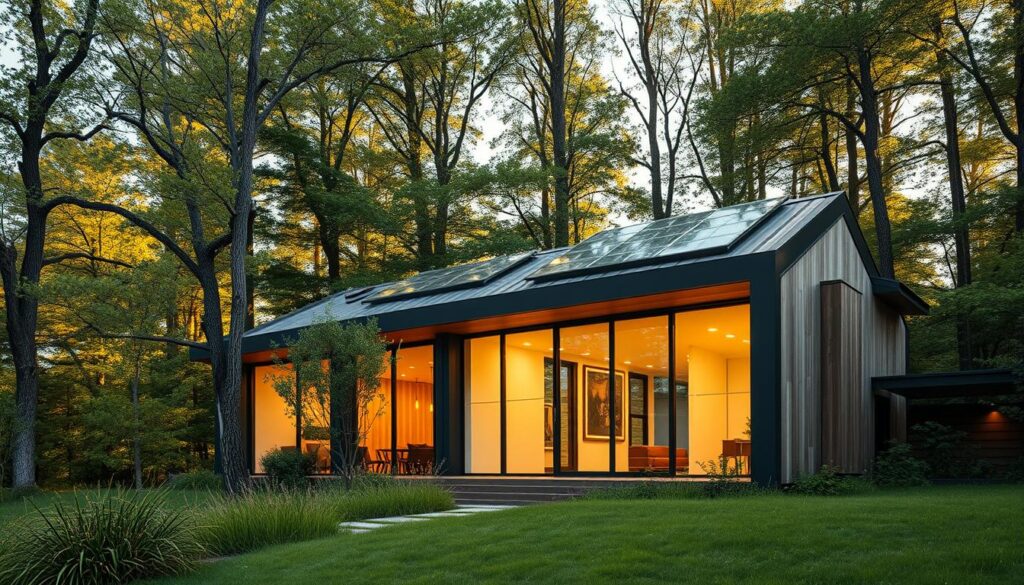
The City of New York’s embrace of sustainable design has yielded impressive results, including significant cost savings and reduced greenhouse gas emissions. This exemplifies the broader benefits of environmentally responsible construction, which are multifaceted and far-reaching.
Cost Savings and Efficiency
One of the primary advantages of green building is the potential for cost savings. By incorporating energy-efficient systems and green building materials, buildings can significantly reduce their energy consumption, leading to lower utility bills. Moreover, sustainable design often results in longer building lifetimes, reducing the need for costly repairs and renovations.
The City of New York’s initiatives have demonstrated that investing in energy-efficient architecture not only benefits the environment but also provides a strong return on investment. For instance, the use of energy-efficient windows and insulation can reduce heating and cooling costs by up to 30%.
Healthier Living Environments
Environmentally responsible construction also focuses on creating healthier living environments. By using non-toxic, sustainable materials and designing buildings that maximize natural light and ventilation, green buildings can improve indoor air quality and enhance occupant health.
Studies have shown that occupants of green buildings report fewer instances of respiratory problems and other health issues related to poor indoor air quality. This is particularly important in urban areas, where air quality can be a significant concern.
Positive Impact on Communities
Beyond the individual building level, environmentally responsible construction can have a positive impact on communities. Green buildings can serve as models for sustainable development, promoting a culture of environmental stewardship and inspiring others to adopt similar practices.
Furthermore, sustainable construction projects often involve community engagement and education, fostering a sense of ownership and pride among local residents. This can lead to stronger, more resilient communities that are better equipped to address environmental challenges.
Materials for Sustainable Construction
The General Services Administration (GSA) emphasizes the use of environmentally preferable products in construction projects, highlighting the importance of material selection. This focus on materials is crucial because it directly impacts the environmental footprint, durability, and healthiness of buildings.
Eco-Friendly Building Materials
Eco-friendly building materials are those that have a lower or reduced negative effect on the environment. Examples include materials that are sustainably sourced, have low VOC (Volatile Organic Compound) emissions, or are made from recycled content. The use of such materials is a key principle of green design, contributing to healthier indoor environments and reduced environmental impact.
“The choice of materials can significantly affect the environmental sustainability of a construction project.”
Recycled and Reclaimed Resources
Using recycled and reclaimed resources in construction not only reduces waste but also conserves natural resources. Recycled materials can range from reclaimed wood to recycled metal and glass. These materials reduce the demand for new raw materials, thereby decreasing the environmental footprint associated with extraction, processing, and transportation.
| Material | Environmental Benefit | Example Use |
|---|---|---|
| Reclaimed Wood | Reduces deforestation | Flooring, Furniture |
| Recycled Glass | Reduces waste, conserves raw materials | Countertops, Decorative Features |
| Recycled Metal | Reduces energy consumption, conserves raw materials | Roofing, Structural Elements |
Locally Sourced Options
Opting for locally sourced materials is another strategy for reducing the environmental impact of construction projects. Local sourcing minimizes transportation-related emissions, supporting local economies and ensuring that materials are well-suited to the local climate and building codes.
By incorporating eco-friendly building materials, recycled and reclaimed resources, and locally sourced options into construction projects, builders can significantly enhance the sustainability of their projects. This not only benefits the environment but also contributes to healthier living environments and can lead to cost savings over the life of the building.
Energy-Efficient Design Strategies
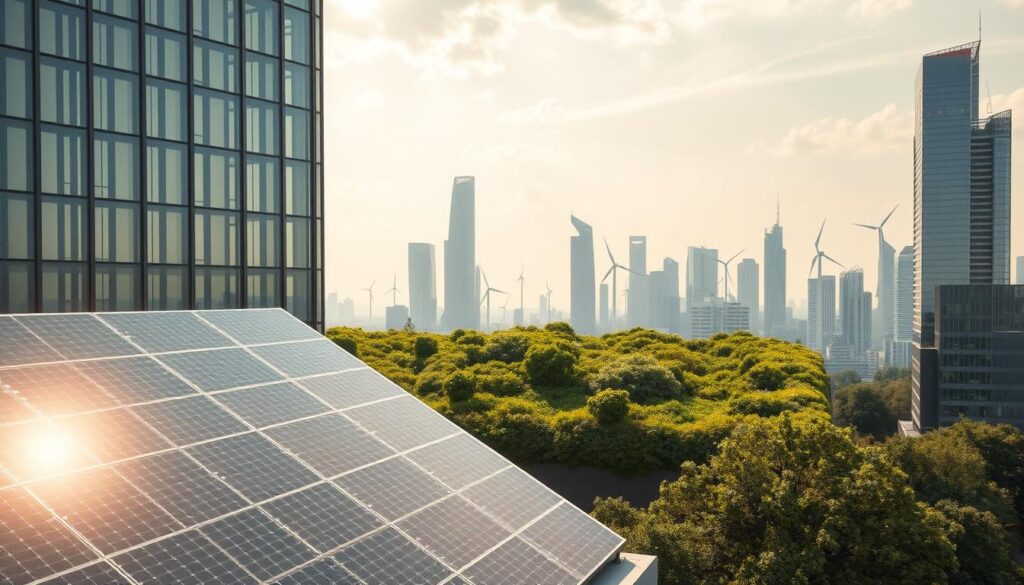
The General Services Administration (GSA) emphasizes the importance of energy-efficient design in federal buildings, requiring federal agencies to design buildings to achieve energy efficiency at least 30 percent better than ASHRAE 90.1 standards. This requirement underscores the significance of incorporating energy-efficient design strategies into building projects to reduce energy consumption and promote sustainability.
Effective energy-efficient design involves several key strategies. One approach is through
Passive Solar Design
, which leverages natural sunlight and heat to reduce the need for artificial lighting and heating systems. By carefully orienting buildings and designing their layouts, architects can maximize the use of natural resources, thereby reducing energy costs.
Use of Energy Star Appliances
. Energy Star certified appliances are designed to use less energy while maintaining performance, making them an essential component of energy-efficient buildings. The GSA’s guidelines encourage the use of such appliances to further reduce energy consumption.
Renewable Energy Sources
are also a critical component of energy-efficient design. By incorporating sources like solar, wind, and geothermal energy, buildings can significantly reduce their reliance on non-renewable energy. The GSA promotes the integration of renewable energy systems into building designs to enhance sustainability. For more information on sustainable design practices, visit theGSA’s Sustainable Design page.
| Energy-Efficient Strategy | Description | Benefits |
|---|---|---|
| Passive Solar Design | Utilizes natural sunlight and heat | Reduces need for artificial lighting and heating |
| Energy Star Appliances | Appliances that use less energy | Lowers energy consumption without sacrificing performance |
| Renewable Energy Sources | Solar, wind, and geothermal energy | Reduces reliance on non-renewable energy, enhancing sustainability |
Water Conservation Techniques
In the quest for sustainability, water conservation techniques play a pivotal role in reducing the environmental footprint of buildings. Effective water management not only conserves this precious resource but also reduces the energy needed to treat and transport water.
The City of New York has been at the forefront of implementing innovative water conservation techniques in its public buildings. One such technique is the use of rainwater harvesting systems, which collect and store rainwater for various uses, reducing the demand on municipal water supplies.
Rainwater Harvesting Systems
Rainwater harvesting involves the collection and storage of rainwater from rooftops, which can then be used for irrigation, toilet flushing, and other non-potable purposes. This technique not only reduces stormwater runoff but also decreases the burden on municipal water treatment facilities. For more information on the latest trends in green infrastructure, visit World Civil Society.
Low-Flow Fixtures
Another effective water conservation technique is the installation of low-flow fixtures, including faucets, toilets, and showerheads. These fixtures are designed to use significantly less water than traditional models while maintaining performance. The use of low-flow fixtures is a simple yet effective way to reduce water consumption in buildings.
Landscaping for Water Efficiency
Landscaping for water efficiency involves selecting plants that require minimal watering and using irrigation systems that deliver water directly to the roots, reducing evaporation and runoff. This approach not only conserves water but also reduces the maintenance required for landscaping.
| Technique | Description | Benefits |
|---|---|---|
| Rainwater Harvesting | Collection and storage of rainwater | Reduces stormwater runoff, decreases municipal water demand |
| Low-Flow Fixtures | Fixtures that use less water | Reduces water consumption, maintains performance |
| Landscaping for Water Efficiency | Plant selection and irrigation management | Conserves water, reduces maintenance |
The Role of Technology in Eco-Friendly Design
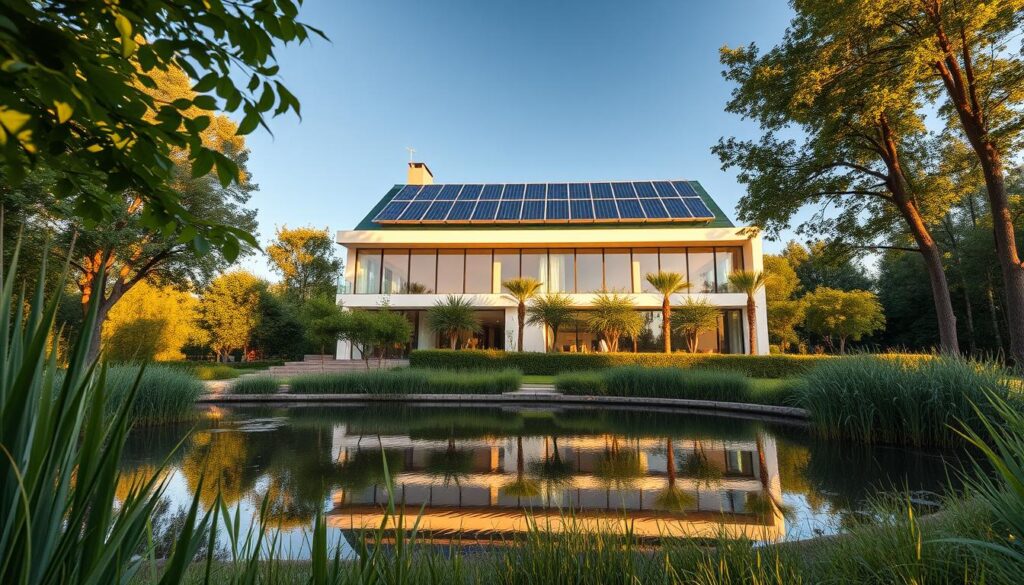
The integration of technology in eco-friendly design has revolutionized the way we approach energy-efficient architecture and adhere to green design principles. By leveraging cutting-edge technologies, architects and builders can now create structures that not only minimize environmental impact but also provide healthier living spaces for occupants.
One of the significant advancements in this area is the development of smart home technologies. These technologies enable homeowners to control lighting, heating, and cooling systems remotely, optimizing energy consumption and reducing waste. For instance, smart thermostats can learn a household’s schedule and preferences to adjust the temperature accordingly, leading to significant energy savings.
Smart Home Technologies
Smart home technologies are transforming the way we live by making our homes more comfortable, efficient, and sustainable. These technologies include smart lighting systems that adjust based on the time of day and occupancy, and smart appliances that optimize energy use during off-peak hours.
Innovations in Building Materials
In addition to smart home technologies, innovations in building materials are playing a crucial role in eco-friendly design. New materials are being developed that are not only sustainable but also offer improved performance characteristics. For example, advanced insulation materials can significantly reduce heat loss in buildings, while materials like recycled glass and reclaimed wood offer sustainable alternatives to traditional building materials.
For more information on the economic and environmental implications of green construction, visit PlanRadar’s article on green construction.
Virtual Design Tools
The General Services Administration (GSA) has been at the forefront of utilizing virtual design tools to enhance the design process and improve building performance. These tools allow architects to simulate various design scenarios, analyze energy efficiency, and predict potential issues before construction begins. By using virtual design tools, the GSA can ensure that their projects are not only sustainable but also meet the needs of their occupants.
As technology continues to evolve, we can expect to see even more innovative solutions in the field of eco-friendly design. By embracing these advancements, we can create a more sustainable future for generations to come.
Choosing the Right Location for a Project
When it comes to sustainable construction, the importance of choosing the right project location cannot be overstated. The location of a project is fundamental to its ability to meet sustainability goals and minimize environmental impact. A well-chosen location can significantly reduce the need for lengthy commutes, lower energy consumption, and promote more efficient use of resources.
Environmental Impact Assessments
Conducting thorough environmental impact assessments is a critical step in the location selection process. This involves evaluating the potential effects of the project on the local ecosystem, including wildlife habitats, water sources, and soil quality. The General Services Administration (GSA) considers these assessments crucial when selecting project locations, ensuring that the chosen site minimizes harm to the environment.
Key considerations in environmental impact assessments include:
- Assessing the site’s biodiversity and potential for habitat disruption
- Evaluating the impact on local water resources and quality
- Analyzing the soil’s condition and potential for erosion
Urban vs. Rural Considerations
The decision between an urban and rural location is another significant factor. Urban areas often offer better access to public transportation, reducing the reliance on personal vehicles and lowering emissions. On the other hand, rural locations might provide more space and natural resources but could require additional infrastructure, potentially increasing the project’s environmental footprint.
Key advantages of urban locations include:
- Proximity to public transportation, reducing the need for personal vehicles
- Access to a broader range of services and amenities
- Potential for more efficient energy use due to density
Access to Public Transportation
Access to reliable public transportation is a vital consideration for sustainable projects. Locations with well-developed public transit systems can significantly reduce the project’s carbon footprint by minimizing the need for personal vehicles. This not only benefits the environment but also enhances the quality of life for occupants by providing them with convenient and sustainable mobility options.
For more insights on designing sustainable buildings, visit top strategies for successfully designing sustainable buildings. By prioritizing locations with good public transportation, projects can better achieve their sustainability goals and contribute to a more environmentally conscious built environment.
Certification Programs in Green Building
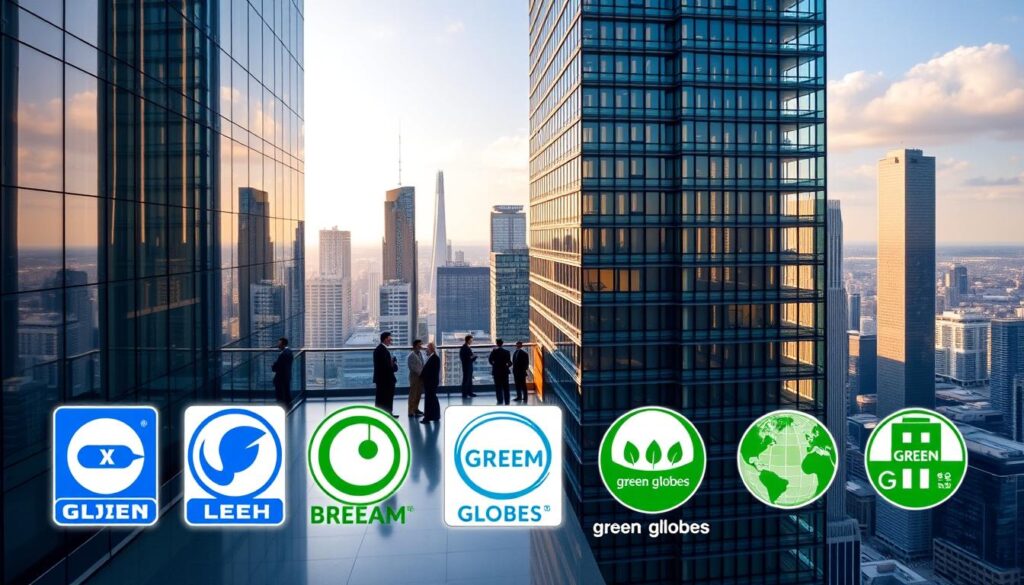
As the world shifts towards more environmentally friendly practices, green building certification programs are gaining prominence. These programs not only promote sustainable building practices but also provide a framework for builders and architects to follow.
The City of New York, for instance, requires a LEED Silver rating for its new construction projects, setting a precedent for other cities to follow. This move underscores the importance of green building materials and practices in modern construction.
LEED Certification
LEED (Leadership in Energy and Environmental Design) Certification is one of the most widely recognized green building certification programs. It is designed to promote sustainable building practices by providing a framework for designing, building, and operating high-performance green buildings. For more information on LEED Certification, visit https://www.usgbc.org/leed.
Energy Star Certification
Energy Star Certification is another prominent program that focuses on energy efficiency in buildings. It is a joint program between the U.S. Environmental Protection Agency and the Department of Energy, aimed at helping businesses and individuals save energy and protect the environment.
Living Building Challenge
The Living Building Challenge is a more rigorous certification program that goes beyond energy efficiency to address a broader range of environmental and social issues. It requires buildings to be net-positive in terms of energy, water, and waste, among other criteria.
To illustrate the differences between these certification programs, consider the following comparison:
| Certification Program | Focus | Key Requirements |
|---|---|---|
| LEED Certification | Sustainable building practices | Energy efficiency, water conservation, indoor air quality |
| Energy Star Certification | Energy efficiency | Energy performance rating, energy-efficient appliances |
| Living Building Challenge | Net-positive energy, water, and waste | Renewable energy, water harvesting, non-toxic materials |
For emerging trends and innovations in green building, exploring resources like https://worldcivilsociety.com/emerging-green-building-innovations/ can provide valuable insights.
Challenges in Sustainable Construction
As the world shifts towards greener construction methods, the industry encounters several challenges. Sustainable construction, while beneficial in the long run, faces obstacles that hinder its widespread adoption.
Cost vs. Benefits
One of the primary challenges is balancing the cost of sustainable construction with its benefits. While eco-friendly construction techniques can lead to significant long-term savings, the initial investment can be prohibitively expensive for some projects. For instance, the use of sustainable materials and energy-efficient architecture can increase upfront costs.
A study on the cost-benefit analysis of sustainable construction projects revealed that while initial costs are higher, the long-term savings on energy and maintenance can offset these expenses. For example, a project that incorporates sustainable practices can reduce energy consumption by up to 30%.
| Cost Component | Traditional Construction | Sustainable Construction |
|---|---|---|
| Initial Cost | $100,000 | $120,000 |
| Energy Costs (10 years) | $50,000 | $35,000 |
| Maintenance Costs (10 years) | $20,000 | $15,000 |
Availability of Materials
The availability of sustainable materials is another significant challenge. The GSA faces difficulties in sourcing materials that meet sustainability standards for its construction projects. This issue is compounded by the need for materials that are not only eco-friendly but also durable and cost-effective.
To address this, some companies are turning to innovative materials and recycling practices. For example, using reclaimed wood or recycled metal can significantly reduce the environmental footprint of a construction project.
Regulations and Standards
Regulatory frameworks and standards for sustainable construction vary widely across different regions, creating another layer of complexity. Compliance with these regulations requires a deep understanding of local laws and standards, which can be challenging for large-scale projects spanning multiple jurisdictions.
To overcome these challenges, it’s essential to stay updated on the latest regulations and standards. For instance, LEED certification is a widely recognized standard for sustainable construction, and understanding its requirements can help navigate the regulatory landscape.
Community Involvement in Sustainable Design
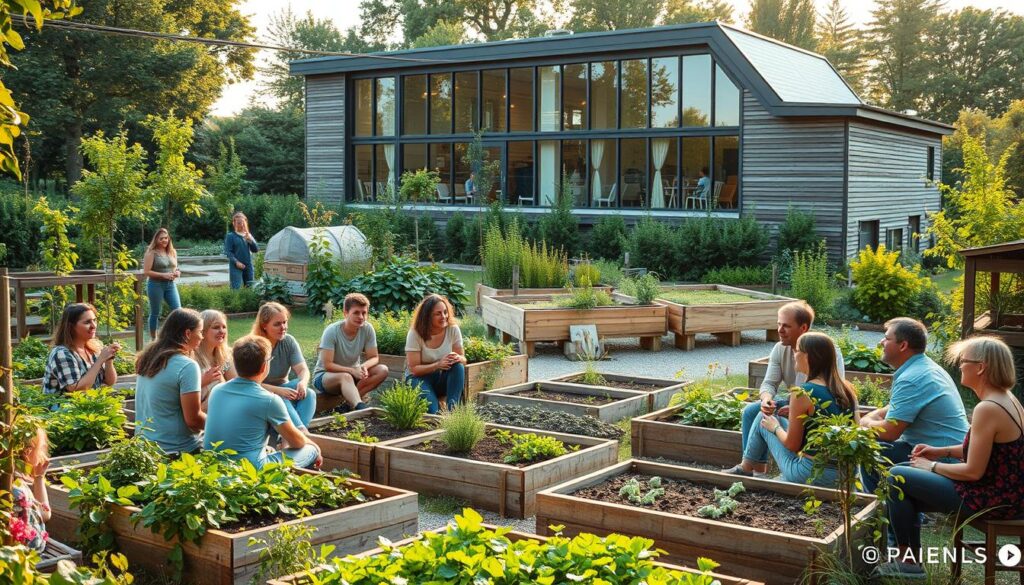
Effective sustainable design requires more than just technical knowledge; it demands community engagement. The City of New York’s initiatives demonstrate how engaging local stakeholders can promote sustainable design and construction practices.
Engaging Local Stakeholders
Engaging local stakeholders is a critical step in sustainable design. It involves understanding the needs and concerns of the community, which can lead to more successful and accepted projects. In New York City, local stakeholders are engaged through public meetings and surveys, ensuring that their voices are heard in the design process.
Key strategies for engaging local stakeholders include:
- Conducting community surveys to understand local needs
- Hosting public meetings to discuss project plans
- Creating community advisory groups to guide the design process
Education and Awareness Campaigns
Education and awareness campaigns play a vital role in promoting sustainable design practices within the community. By educating stakeholders about the benefits of sustainable design, cities can build support for green initiatives.
| Campaign Type | Description | Impact |
|---|---|---|
| Workshops | Hands-on training for community members | Increased knowledge of sustainable practices |
| Public Seminars | Educational events on sustainable design | Raised awareness among a broader audience |
| Online Resources | Accessible guides and tutorials | Convenient learning for a wider audience |
Collaborative Design Processes
Collaborative design processes involve working closely with stakeholders to develop design solutions that meet community needs. This approach not only fosters a sense of ownership among community members but also leads to more innovative and effective designs.
The benefits of collaborative design include:
- Increased community buy-in and support
- More tailored and effective design solutions
- Enhanced creativity through diverse perspectives
By embracing community involvement, cities can create sustainable designs that are not only environmentally friendly but also socially and economically viable.
The Future of Environmentally Responsible Design
The General Services Administration (GSA) is at the forefront of exploring new technologies to enhance sustainable design and construction practices. This commitment to innovation is crucial as the construction industry continues to evolve.
Trends in Sustainable Architecture
Sustainable architecture is witnessing a significant shift towards environmentally conscious building solutions. Trends include the incorporation of green roofs, solar panels, and the use of green building materials that are recycled, recyclable, or sustainably sourced.
For more insights on how technology is transforming the construction industry, visit how AI is transforming civil engineering.
Innovations on the Horizon
Innovations in sustainable design are not limited to materials; they also include advanced technologies like Building Information Modeling (BIM) and energy-efficient systems. These innovations are making it possible to construct buildings that are not only eco-friendly but also highly efficient.
Policy Changes and Government Support
Government policies and support play a crucial role in promoting sustainable design. Initiatives like tax incentives for green buildings and strict building codes are encouraging the adoption of environmentally conscious building solutions.
| Trend/Innovation | Description | Benefit |
|---|---|---|
| Green Roofs | Roofs partially or completely covered with vegetation | Reduces urban heat island effect |
| Solar Panels | Panels that convert sunlight into electricity | Renewable energy source |
| Green Building Materials | Materials that are sustainable, recycled, or recyclable | Reduces environmental impact |
Case Studies of Successful Green Projects
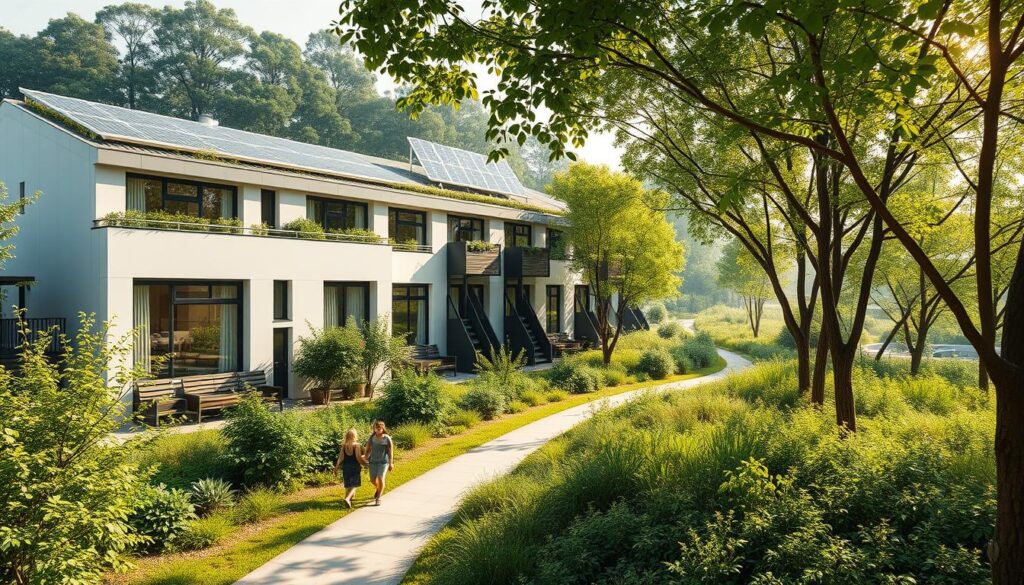
Examining case studies of successful green projects provides valuable insights into sustainable design and construction methods. These projects not only showcase innovative eco-friendly construction techniques but also highlight the benefits of sustainable building practices.
Iconic Green Buildings in the U.S.
The United States is home to numerous iconic green buildings that have set new standards for eco-friendly construction techniques. For instance, the City of New York has implemented several successful green projects, including the renovation of public buildings to make them more energy-efficient. These projects demonstrate how sustainable design can be integrated into urban landscapes.
- The Bullitt Center in Seattle, known for its net-positive energy and water usage.
- The Edge in Amsterdam, recognized as one of the most sustainable office buildings globally.
- The VanDusen Botanical Garden Visitor Centre in Vancouver, featuring a living roof and rainwater harvesting system.
Lessons Learned from Sustainable Designs
Analyzing successful green projects reveals several key lessons. Firstly, the importance of integrating sustainable building practices from the outset of a project cannot be overstated. Secondly, the use of eco-friendly construction techniques can significantly reduce environmental impact. Lastly, community engagement is crucial for the long-term success of green projects.
- Early integration of sustainable design principles.
- Selection of materials with low environmental impact.
- Community involvement in project planning and maintenance.
Community-Based Projects
Community-based green projects are vital for promoting sustainability at a local level. These projects often involve the renovation of existing buildings or the construction of new facilities using sustainable building practices. The City of New York’s green projects serve as a model for community-based initiatives, demonstrating how local governments can drive change through sustainable design and construction.
By examining these case studies, it becomes clear that successful green projects require a multifaceted approach that includes innovative design, community engagement, and a commitment to eco-friendly construction techniques.
Financing Environmentally Responsible Construction
Environmentally responsible construction projects often face financing challenges, but various green loans and incentives can help overcome these hurdles. The incorporation of energy-efficient architecture and green design principles not only benefits the environment but also offers long-term financial advantages.
Green Loans and Incentives
Green loans and incentives are pivotal in supporting projects that adopt sustainable practices. These financial instruments are designed to encourage the development of energy-efficient buildings and the use of green design principles. For instance, the General Services Administration (GSA) offers various funding opportunities for sustainable projects, demonstrating how government agencies can play a crucial role in promoting environmentally responsible construction.
Funding Opportunities for Sustainable Projects
Several funding opportunities are available for projects that incorporate sustainable design and energy-efficient architecture. These include government grants, private investments, and specialized loan programs. By exploring these options, developers can secure the necessary financing to implement green design principles and achieve their sustainability goals.
Long-Term Financial Benefits
Investing in energy-efficient architecture and green design principles can lead to significant long-term financial benefits. These benefits include reduced energy costs, lower maintenance expenses, and potentially higher property values. By understanding and leveraging these advantages, developers and property owners can make informed decisions that support both their financial interests and their commitment to sustainability.
The Importance of Maintenance in Sustainability
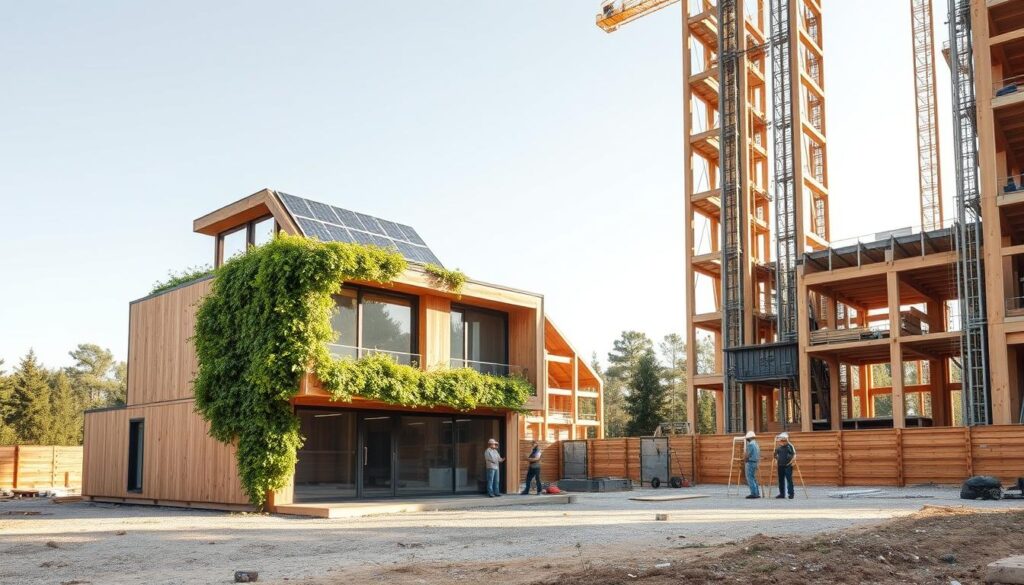
To ensure the longevity of green buildings, regular maintenance is essential. This involves a combination of ongoing energy efficiency practices, regular assessments and upgrades, and active community roles in maintenance.
Ongoing Energy Efficiency Practices
Maintaining energy efficiency is crucial for the sustainability of buildings. This can be achieved through the use of Energy Star appliances and regular checks on building systems to ensure they are operating at optimal levels. For instance, the City of New York conducts regular assessments and upgrades to maintain energy efficiency in its public buildings, demonstrating a proactive approach to sustainability.
Regular Assessments and Upgrades
Regular assessments are vital to identify areas where upgrades can improve sustainability. This includes evaluating energy consumption patterns and implementing changes such as installing LED lighting or enhancing insulation. Upgrades not only improve energy efficiency but also contribute to cost savings over time.
- Conducting energy audits to identify inefficiencies
- Implementing smart home technologies to monitor energy use
- Upgrading to energy-efficient appliances and systems
Community Roles in Maintenance
The community plays a significant role in maintaining the sustainability of green buildings. Education and awareness campaigns can empower building occupants to adopt sustainable practices, such as reducing water usage and recycling. Furthermore, involving the community in maintenance decisions can foster a sense of ownership and responsibility towards the building’s sustainability.
- Organizing workshops on sustainable living practices
- Encouraging feedback from building occupants on maintenance needs
- Promoting community involvement in green initiatives
By combining these strategies, buildings can not only reduce their environmental footprint but also provide healthier living environments for their occupants. The importance of maintenance in sustainability cannot be overstated, as it ensures that sustainable construction innovations continue to deliver benefits over the long term.
Conclusion: Embracing a Sustainable Future
As we move forward, it’s clear that environmentally responsible design and construction methods are crucial for a sustainable future. The General Services Administration (GSA) and the City of New York are setting a positive precedent by promoting sustainable building practices in their projects.
Key Takeaways
Sustainable engineering practices significantly reduce carbon footprints, conserve resources, and promote eco-friendly technologies. The triple bottom line approach emphasizes the importance of “People, Planet, and Profit.”
Industry Call to Action
Professionals in the industry must continue to adopt and innovate sustainable building practices. This includes leveraging digital technologies, energy-efficient systems, and circular economy approaches to minimize waste and maximize resource efficiency.
Future Vision
As we envision future projects, it’s essential to prioritize sustainability, incorporating green building materials, renewable energy sources, and sustainable construction techniques. By doing so, we can create a more sustainable and environmentally conscious built environment.
